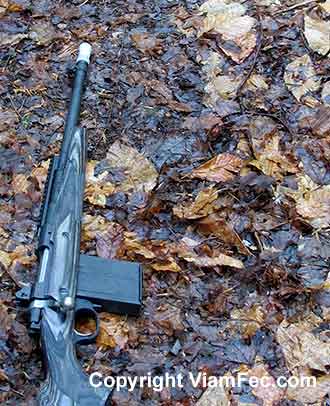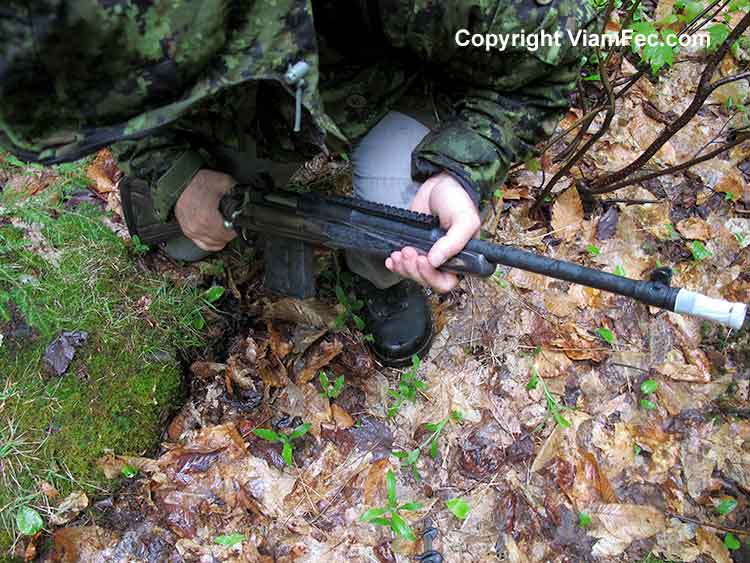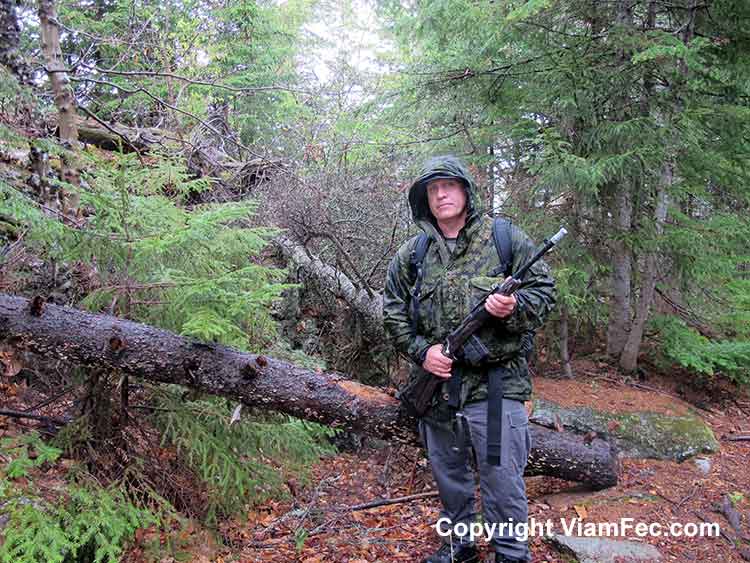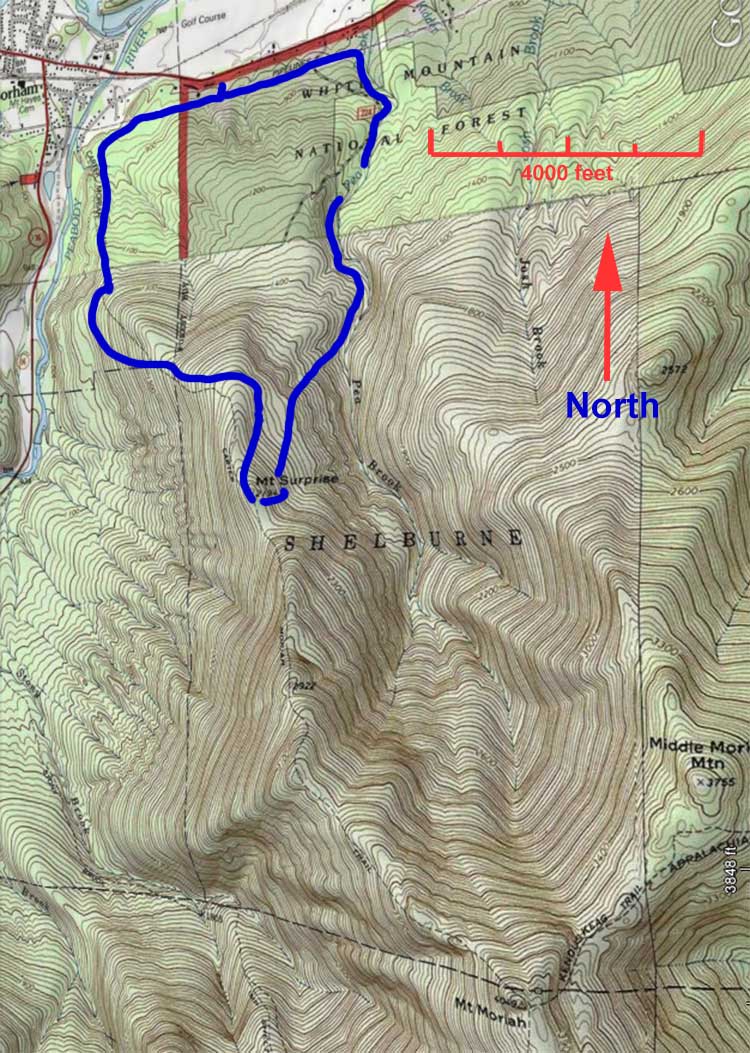
On my third scout on the slopes of Mount Surprise Viam Fec made a way to its first mountain summit in the White Mountains in the Great North Woods.
It’s been a day of constant drenching rain, increasingly thick jungle-like foliage as trees and shrubs sprout fresh Spring leaves and shoots, blown-down trees by the thousands, and a most enjoyable day being wet, cold, and un-miserable.
“Un-miserable”? Yes. I don’t have a word for how I feel, and so went ahead and made one up.
Conditions:
- Temperature 45 to 55 degrees F
- Heavy rainfall most of the day
- Deciduous leaves still coming out
- Black flies and mosquitoes becoming more bothersome
- Forest cover: perhaps at 60% of full summer leafout. Areas of conifers and intermittent conifer trees provide some cover.
Human Contact
- Hikers
Animal Contact
- Domestic dogs
- Very fresh moose and deer tracks
Area Covered
- About 3.5 miles of bushwhack through forest
- About 1.5 miles on trail and pipeline right of way
On the Trail
Today I parked my truck near the Bangor Street, Mount Moriah trailhead and merged into the thick wet forest in a drenching rain. Upon climbing the first small hill, I cut what used to be the Appalachian Trail until it was re-routed east in Shelburne. However this, the Carter-Moriah Trail, still remains a main route for hikers up the the 2149-ft Mount Surprise and then further on the 4049-ft Mount Moriah
Here can be found a very old Appalachian Trail marker made out of galvanized steel. Some 40-years ago when I was a kid you could still see the AT symbol on it, though now it is rusted somewhat.
This sheet of metal also sports a number of bullet holes, as do many a sign in this area. After all it is a good target on which to check the zero of a rifle. Some of these holes may have come from my old 300-savage when I was young and didn’t know better.


When this picture was taken there was a brief lull in rainfall. Walking up steep hills produces alot of body heat – so when it is raining a man can either be drenched in sweat underneath a raincoat or drenched in rain without a raincoat.
Your choice.
Since I was on an open trail with no wet leaves and shrubs to brush against, I took the opportunity to remove my rain gear and cool off a bit.
Notice in the picture how I draped the raincoat over the backpack. This may be key to what happened further along the trail when I met a certain species of animal.
Two Black Triangles
Because walking up the cleared hiking trail was so very much easier than slogging through the dense undergrowth of the forest, I decided to walk several hundred yards uphill to a sharp bend I know the trail makes. From there I would merge back into the forest to continue my scout as a bushwhack to the summit.
As usual, this turned out to be a mistake.
I was discovered.
As I very slowly walked up the trail, my camo parker draped across my backpack and flowing in the light breeze, I turned around to check the trail behind me. I instantly recognized a familiar color and a shape.
A pair of large black triangular shapes side by side, of the color black.

Black is Poor Camouflage
Contrary to what many people believe, black is not a good camouflage color. In fact, pure dark black is probably one of the worst camo colors of all – even at night. As soon as my peripheral vision saw an object colored black my mind was on immediate alert. Microseconds later as my alerted eyes focused on the offending spot I noticed that black patch in the brown and green forest was a set of pointed triangular dog ears.
I will do write-up in the Lessons Learned category discussing my views on the color black.
The black dog stood near the crest of a minor hill, visible from the shoulders up, looking back down the trail toward what was likely its owner.
As is the nature of dogs, this dog had run ahead and was waiting for someone to catch up. But why didn’t the dog notice me? I have a theory.
Inadvertent Camouflage Technique
Look at the picture above, where I have my green camo parker draped over my backpack as I look at the Appalachian Trail sign. This is something of what the dog would have seen when cresting the hill (only looking straight on to my back). In the dogs eyes what he may have seen is the camo cloth removing most of the outline of my body instead of the instantly reconizable shape of a human body with head-torso-two-legs.
What’s more, as the parker slowly swayed back and forth as I walked it may have seemed to the dog like vegetation swaying in the breeze.
If the dog was scanning ahead as it ran, it did not see a human shape in the near distance nor did it notice any movement out of the ordinary – just a bush gently rocking back in forth in the breeze as is the nature of bushes.
As soon as my brain registered the dog, I silently cut to the right into the thick forest about 50-feet and a short way down an embankment. The fact that it the duff on the forest floor was wet made for silent walking without the sound of crushing vegetation and twigs was a great aid for stealthily exiting the scene.
A minute or so later barking could me heard and a human command to “come here”. No doubt the dog could sense me crouching just down over the embankment and the owner probably thought the commotion was over nothing but a deer or other animal.
Experiment in Human Awareness
Now that my cover had been blown through my own laziness, I thought to conduct a little experiment. Knowing that locals often walk these trails a short way and then return to the valley below, I leaned my rifle at a 45-degree angle against a tree located about 30 feet off the trail – in plain sight – and then stood in the trail and waited.
Within about 5-minutes here comes the black dog, a white dog, and a brown dog, all weighing between 35 and 50 pounds followed by their owner. We exchanged some pleasantries as the dogs sniffed and investigated me and then the hiker went on his/her way. I was careful to watch if the rifle leaning against the nearby tree was spotted. It was not.
I was also rather surprised that the dogs did not run to the tree that the rifle was leaning against.

Back Off-Trail Where a Scout Belongs
Having learned my lesson, hopefully for the last time, I turned left off the trail and back into the thick jungle-like wet forest. It was raining again, a steady downpour that continued for the remainder of the day. Up, up, up, ever upward through hobble bushes and over and around uncounted blown down trees.
If you have ever bushwhacked off-trail in the northern forest, you will find that it probably requires upwards of 5 to 10 times as much effort to go a given distance than it does on a maintained trail.
In short order I came upon a fresh set of moose tracks, water in the prints still muddy. While moose can be just about anywhere in these forests, finding fresh tracks is a clue to stay especially alert. While walking through thick brush it is easy to suddenly find yourself face to face with a wild, ornery creature that can weight up to 1200 pounds or more.
While a black bear will almost 100% of the time run when in contact with a human (unless someone has been feeding the bears), a moose does not always do so. Dealing with a angry moose can be problematic indeed. Possessing long legs and with powerful physique, a moose can plow through dense vegetation faster than a man can run even on open ground.

What this means is, even armed, a man is no match for the sudden charge of an angry moose. Best to keep a sharp eye out for this most dangerous of North Country animals.
As I neared the summit of the mountain, the soil gradually became thinner and the forest trees changed. From a mostly deciduous forest with some trees of gigantic size, I started seeing more spruces. The forest floor supporting large colonies of ferns, mosses and lichens.
Suddenly there it was, the Summit of Mount Surprise. On cloudless days there is a stupendous view of Mount Washington and the Presidential Mountains Range from the ledges here. However today the mountains were completely socked in by clouds and fog as the rain continued to pour down.

Setting up the camera tripod in preparation for taking a picture of the first Viam Fec summit, two hikers suddenly appeared. They were coming down from the higher Mount Moriah, in full rain gear, wet, and apparently exhausted. Exchanging pleasantries, one of them mentioned the summit of Moriah was completely in the clouds and it was too windy to stay there long.
During the conversation there leaned my Scout Rifle against a tree nearby – the hikers never noticed it.
Camera Hex Strikes Again
From the summit of Mount Surprise I plunged north down the rugged and very steep Pea Brook valley that drains the northern mass of Mount Moriah.
Not far down I came upon the best natural rock cave I have ever discovered here in the Great North Woods. Measuring about ten-feet wide by eight feet high, you can easily walk underneath an overhanging rock for ten feet.
Setting up to take a picture, the camera dies. The battery is out of power.
Failing gear has occurred on nearly every scout. This must be rectified.
Decent into Pea Brook Valley
From the summit of Mount Surprise I plunged down the steep west slope, quickly trending in a northeast direction through thick forest.
Down, down, down, my way went over rocks and blow downs. As I eventually reached Pea Brook in the pouring rain I was rather surprised the rushing brook was not too deep to cross, albeit by plunging into the cold water and wading across at knee level. On the opposite shore I removed my boots, emptied them of water and wrung out my wool socks.
Always wear wool socks – never cotton.
Back on my way in the pouring rain, past incredible waterfalls, rushing rapids, and deep crystal clear pools I dropped 1300 feet in about two miles, with the first half of the descent probably three times as steep as the last half.
Soaking wet to the bone, a little chilled in the 50-degree F temperature, I slogged my way back to the truck via the Portland to Montreal natural gas pipeline a few hours before dark.
Scout Map

Key Takeaways
- Using trails is very problematic due to easy discovery by locals. Don’t use trails!
- The Artktis B310 Rain Parker is outstanding gear.
- Using finger bandages to block a gun barrel from rain and debris is only a mediocre solution at best.
- Rain and wet forest conditions aid in stealth by dampening noise caused by rustling foliage and footsteps on forest floor duff.
- People are generally not very observant, they will often not see objects that are hidden in plain sight.
- Dogs can easily discover you, but they also make it easier to discover the people they accompany.
- Dogs are not infallible, they can be deceived with good camouflage or movement techniques.
- Pure black as a color stands out plainly in natural environments, and is easy to see with even peripheral vision.
- Check gear, check gear, check gear before each and every scout: in this case the camera battery lost its charge midway through the scout.
Related Posts
- Mount Surprise Scout 1 May 15, 2014
- Mount Surprise Scout 2 May 20, 2014